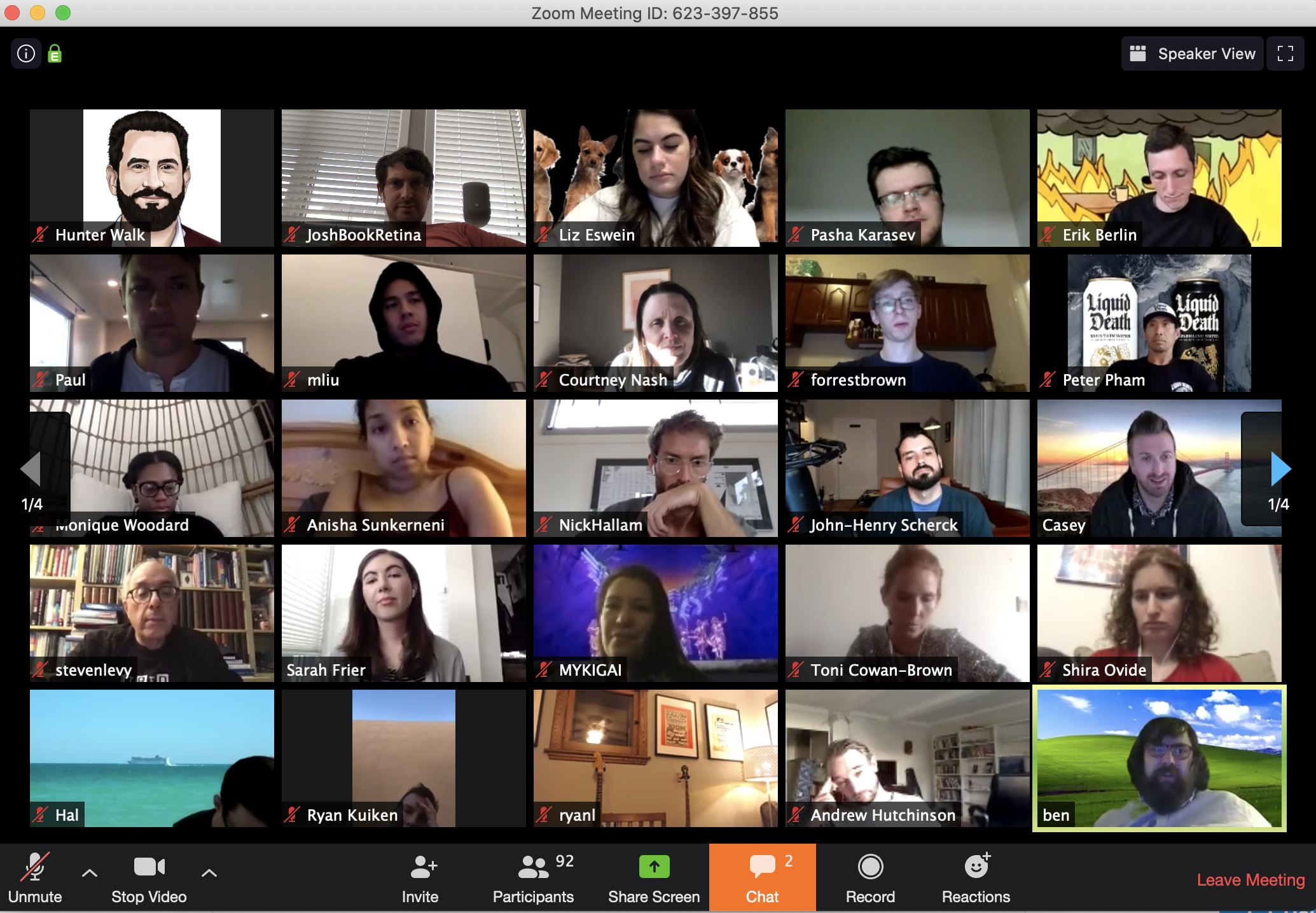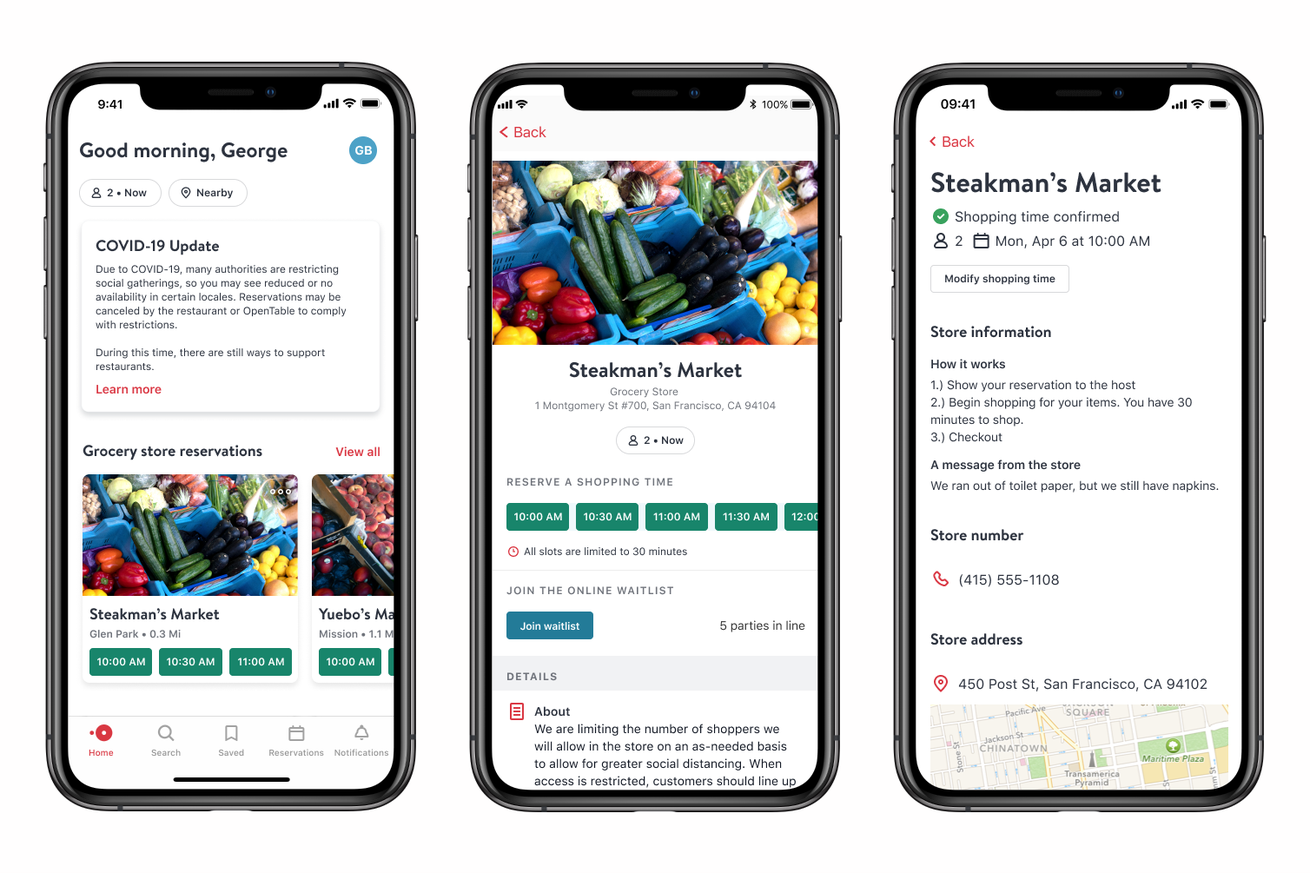
- As the coronavirus crisis forces people to work remotely, tools that help them stay connected and productive are booming in popularity.
- We asked a select group of VCs to name enterprise startups that could take off this year as a result of the changing work environment.
- Each investor named two "future of work" startups: one in their portfolio, and one company they admire but have no financial interest in.
-
Visit Business Insider's homepage for more stories.
The coronavirus outbreak has changed not only where people work from, but how they work and what tools they use.
Already, apps like Zoom and Slack have seen huge increases in usage in the past few weeks, as users grab onto ways to stay connected in their work and personal lives while social distancing.
The urgent need for better work tools could catapult some enterprise startups into the pantheon of unicorn startups, as their users multiply and venture capital investors jump to fund them.
We wanted to find the startups that are already transforming the future of work, defining the new ways in which people are doing their everyday jobs. We reached out to a select group of venture capitalists with enterprise bets in their portfolios and asked them to name the startups that are positioned to have very good years.
When we spoke to each investor, we set some ground rules for participation:
- The VC had to tell us about one startup in their portfolio. After all, they had enough conviction in the company to write it a check.
- We also asked them to name one "future of work" startup where they have no financial interest. Those are the companies they're closely watching, maybe with a bit of envy.
Their nominations cover all aspects of work, from processes like recruiting and onboarding to products such as video conferencing, chatbots, and email.
Here are the 30 startups they named, listed in alphabetical order:
SEE ALSO: Silicon Valley's startups are facing the biggest crisis in a generation. Here's what venture capital investors say businesses should do to stay healthy and survive.
NOW READ: The three kinds of software you need to manage and run a remote company, according to a tech CEO who's been doing it since 2011
Airtable: A smart spreadsheet app with a cult following in tech

Startup: Airtable
VC: Benjamin Ling, Bling Capital
Relationship: Investor
Total funding raised: $170 million
What it does: Airtable is a cloud-based spreadsheet tool. It lets users build their own custom apps without any coding.
Why it will boom in 2020: Airtable, which was last valued at $1.1 billion, has found a fanbase that uses it for everything from project management to spreadsheets. Ling said Airtable is "redefining the way users interact with spreadsheets, databases, calendars, etc. in a more flexible and extensible way."
In 2020, Airtable is expanding into new engineering and sales and marketing centers in the San Francisco Bay Area and Austin, Texas, respectively, as the company looks ahead to its next phase of growth.
BeyondHQ: Full-stack support for opening satellite offices

Startup: BeyondHQ
VC: Hunter Walk, Homebrew
Relationship: No financial interest
Total funding raised: $1.9 million
What it does: BeyondHQ helps startups build and staff up satellite offices in new locations, outside of big tech hubs.
Why it will boom in 2020: As the cost of living in Silicon Valley only increases, companies are already thinking about hiring elsewhere. Walk said his firm is seeing more and more of its portfolio companies think about setting up multiple headquarters at earlier stages to attract the best hires.
"Companies like BeyondHQ will make this a snap," Walk said.
Charthop: An automated org chart

Startup: Charthop
VC: Dasha Maggio, Felicis Ventures
Relationship: No financial interest
Total funding raised: $5 million
What it does: A management app that aims to modernize and automate a company's organizational chart, making the whole process more transparent.
Why it will boom in 2020: The company is trying to bring transparency to an aspect of running a company that is typically opaque and difficult to analyze. Maggio said that "people-data, especially organizational structure and design, is one of the final frontiers of company-data."
Allowing companies to analyze that organizational data and use it for company planning is a "game-changer," she said. It raised its seed round of funding last September and has been steadily gaining more traction since.
Cleo: A support system for working parents and their families

Startup: Cleo
VC: Kristin Baker Spohn, CRV
Relationship: No financial interest
Total funding raised: $40.3 million
What it does: A parental benefits app that partners with companies to offer services and advice for working parents.
Why it will boom in 2020: Cleo bills itself as filling a gap between what healthcare plans offer employees and what everyday working parents need to be successful at work and at home.
Now, as many parents and caregivers are having to work from home while also caring for their children, Spohn thinks the need for this kind of support will only grow. She also has faith in the company's newly installed chief executive, Sarahjane Sacchetti, "leading the company into its next phase."
Daily.co: 1-click video calls

Startup: Daily.co
VC: Katie Jacobs Stanton, Moxxie Ventures
Relationship: Investor
Total funding raised: $2.6 million
What it does: Daily.co makes it easy for websites to add video-chat integration.
Why it will boom in 2020: As much of the global workforce starts working from home, it's not surprising that video chat is booming. Stanton said Daily.co will explode because "they could be to video what Stripe is for payments."
Daily.co was also nominated for this list by another Daily.co investor, Jenny Lefcourt, a partner at Freestyle Capital.
"I thought 2020 was their year before COVID-19 but now, as you can imagine, every company needs video chat capabilities as soon as possible — and doesn't want to take their communities and traffic off-platform to do Zoom, Google Hangouts, etc.," Lefcourt said.
Deel: Payroll for remote teams

Startup: Deel
VC: Ryan Hoover, Weekend Fund
Relationship: Investor
Total funding raised: Undisclosed
What it does: Deel is a payroll service for businesses working with remote contractors around the world. It handles contracts, payments, and taxes in one interface, and takes the hassle out of complying with local labor laws.
Why it will boom in 2020: "Many startups are likely breaking local laws when they hire contractors in other countries, and understandably so," Hoover said. "Compliance with local laws is difficult to understand and follow. Deel simplifies all of this."
Since Hoover's firm invested, Deel has seen double-digit growth month-over-month, and now has hundreds of customers in more than 150 countries.
"As distributed working continues to rise, they're in an excellent position to capitalize on this macro trend," he said.
Doctor on Demand: An app for virtual healthcare visits

Startup: Doctor on Demand
VC: Karan Mehandru, Trinity Ventures
Relationship: No financial interest
Total funding raised: $165 million
What it does: Doctor on Demand is an app that connects patients and doctors for virtual medical and mental health visits.
Why it will boom in 2020: With the coronavirus crisis already stretching the healthcare system, telemedicine has become an essential tech to alleviate some of the pressure, Mehandru said.
He added that already in the last few years, new legislation has allowed more people to access care through an app. Now, a sense of urgency around the coronavirus outbreak will establish telemedicine as part of a "new normal."
"Doctor on Demand is sitting squarely as a company that is positioned to benefit immensely from these trends and events," Mehandru said.
Drift: A smarter, more personal chatbot for businesses

Startup: Drift
VC: Shruti Gandhi, Array Ventures
Relationship: No financial interest
Total funding raised: $107 million
What it does: Drift is a conversational marketing and sales app that helps convert web traffic into sales meetings. Its chatbot uses artificial intelligence to make interactions feel more personal.
Why it will boom in 2020: "Drift can help you manage your customers with less people 24/7," Gandhi said. "The employees can all be remote and global and can answer customer requests from anywhere."
Fellow: A meeting agenda software

Startup: Fellow
VC: Dasha Maggio, Felicis Ventures
Relationship: Investor
Total funding raised: $6.5 million
What it does: Fellow is an employee-management software that makes meetings more effective by organizing notes, action items, and feedback.
Why it will boom in 2020: "Everyone says people are a company's most important asset," Maggio said, "but until now, managers haven't had actionable tools. We loved that Fellow created a beautiful product built for managers and believed they were onto something big based on how quickly they were expanding within organizations."
"As more and more companies rapidly shift to working remotely, it's critical to have great tools to stay productive, connected and in sync. Fellow enables teams to do just that," Maggio added.
Figma: A shared workspace for web design teams

Startup: Figma
VC: Jeff Morris, Jr., Chapter One Ventures
Relationship: No financial interest
Total funding raised: $82.9 million
What it does: Figma helps web design teams create, test, and ship designs from its cloud-based software, which allows them to work on designs in tandem much as they would in something like Google Docs.
Why it will boom in 2020: "Figma continues to innovate and set the pace for product design tools," said Morris, Jr. "Their software makes design and prototyping a truly collaborative process, and I am now seeing 'Figma for X' startups being pitched all the time. This is a strong signal for how respected Figma has become in Silicon Valley."
Front: A shared email inbox app

Startup: Front
VC: Arjun Sethi, Tribe Capital
Relationship: Investor
Total funding raised: $138.4 million
What it does: Front takes a team-based approach to email. It combines a company's social media, email, texts, and other messages into a shared inbox to which the entire team has access.
Why it will boom in 2020: Front is trying to disrupt the most used tool in the modern workplace: email.
"We believe that sharing an inbox and collaborating is the way all knowledge workers should be communicating on subjects and topics," said Sethi, an early investor in Front. "It's a slight nuance and collaboration never seen before in email."
Guru: A better knowledge database

Startup: Guru
VC: Jake Saper, Emergence Capital
Relationship: Investor
Total funding raised: $38 million
What it does: Guru uses browser extensions and Slack plugins to make sure the information that workers need to do their jobs "finds them wherever they need it," according to Saper.
Why it will boom in 2020: Saper thinks they are "poised for continued acceleration in 2020 because they are critical to helping distributed teams get work done." The investor added, "as more companies shift to distributed work, Guru will become increasingly critical to effective collaboration."
Hone: Online classes for leadership development

Startup: Hone
VC: Jomayra Herrera, Cowboy Ventures
Relationship: Investor
Total funding raised: $3.6 million
What it does: Hone lets companies offer their employees live, online training on topics like diversity, conflict management, and team-building, that they can stream from anywhere.
Why it will boom in 2020: Given the rise of distributed teams, Herrera said companies are eager to make available more remote learning tools for their employees. "The pace of moving to a more flexible workforce is only accelerating," Herrera said, "and Hone is in a great position to support teams as they need accessible and scalable learning solutions."
Hone was also nominated for this list by Jake Saper of Emergence Capital, who is not an investor.
"Hone has developed a robust platform on top of Zoom that allows world-class trainers to access and interact with organization managers world-wide," said Saper, whose firm backed Zoom before its initial public offering. Hone has "great early customer champions and are poised to scale quickly in 2020."
Incredible Health: A recruiting service for hospitals

Startup: Incredible Health
VC: Jomayra Herrera, Cowboy Ventures
Relationship: No financial interest
Total funding raised: $17.4 million
What it does: Incredible Health is an online recruitment tool for hospitals to hire nurses through automation.
Why it will boom in 2020: Herrera said that customers who use the tool have been able to reduce the time it takes to hire from 90 days to 30 days on average.
"With the projected shortage in nurses in the US, Incredible Health plays an important role in ensuring hospitals are well positioned to fill job vacancies with high-quality candidates quickly," Herrera said.
Invisible: A way to automate the most boring and mundane parts of work

Startup: Invisible
VC: Masha Drokova, Day One Ventures
Relationship: Investor
Total funding raised: $9 million
What it does: Invisible lets businesses offload some of their most repetitive tasks, like posting job descriptions across the internet or following up on sales leads, to free up their employees.
Why it will boom in 2020: Drokova said currently, workers spend at least 69 work-days a year completing mundane tasks. Invisible wants to reduce the time people spend on administrative work.
"More than ever, knowledge workers' time is best spent on strategy, identifying new markets, building and maintaining customer relationships," Drokova said. "Time-consuming reporting and administrative work is less valuable, and Invisible enables companies to easily outsource these tasks and give back time to teams for high-value work."
Level: A dental care insurance plan that works simply for employees

Startup: Level
VC: Hunter Walk, Homebrew
Relationship: Investor
Total funding raised: $3.8 million
What it does: Level aims to cut through bureaucracy with a dental plan that makes finding a provider easy and offers price transparency. The employer only pays for the care its employees use.
Why it will boom in 2020: "What happens when a team of ex-Oscar, Square, and Uber folks reimagine what corporate benefits should be? You get Level," Walk said. "Starting with dental benefits, Level is improving employee healthcare by offering a new way to find, manage, and pay for care."
Linear: A better bug-tracker

Startup: Linear
VC: Semil Shah, Haystack and Lightspeed Venture Partners
Relationship: No financial interest
Total funding raised: $4.2 million
What it does: Linear's workflow software helps developers streamline their projects, tasks, and bug-tracking, to help them work faster and more efficiently.
Why it will boom in 2020: Linear has a "beautiful, opinionated design that's trying to own a very important demographic and information flow inside companies: how software is actually planned and developed and deployed," Shah said.
Loom: An alternative to long emails

Startup: Loom
VC: Ryan Hoover, Weekend Fund
Relationship: No financial interest
Total funding raised: $45 million
What it does: A video messaging app that lets users record short videos, rather than type long emails or spend time in meetings, to get their ideas across.
Why it will boom in 2020: "Communicating nuance and complex ideas online is especially challenging for distributed teams," Hoover said. "Text takes too much time to write and lacks fidelity. Synchronous video communication requires calendar coordinate, which is especially difficult for those working across time zones.
He added: "Loom strikes the perfect balance and has become one of my favorite tools for communicating design feedback, reporting bugs, and explaining product ideas with our distributed team at Product Hunt," the company Hoover cofounded.
Loom has been around since 2016, but Hoover said the company could see greater demand as more people work from home because of the coronavirus.
Miro: A virtual whiteboard for distributed teams

Startup: Miro
VC: Sonali de Rycker, Accel
Relationship: Investor
Total funding raised: $26.3 million
What it does: Teams can build and develop ideas from anywhere using Miro's virtual whiteboarding software.
Why it will boom in 2020: "Miro is a collaborative whiteboard platform for distributed teams," de Rycker said. "It helps companies work in real-time or asynchronously on an infinite canvas for product development, user experience and design, strategy, projects, and mind mapping."
"As teams are increasingly distributed across small and large organizations, companies lack the tools to collaborate in a remote context which made us really excited about Miro's proposition," de Rycker added." "It's impressive to see such high organic adoption rates with 3.5M million users already and more to come!"
Miro was also nominated for this list by another venture capitalist, Talia Goldberg of Bessemer Venture Partners. She is not an investor.
Notion: An "OS for startups"

Startup: Notion
VC: Arun Mathew and Sonali de Rycker, Accel
Relationship: No financial interest
Total funding raised: $70.9 million
What it does: Notion aims to be an "all-in-one workplace," where teams can write notes, track projects, build spreadsheets and databases, and get organized.
Why it will boom in 2020: "Notion is one of the fastest-growing tools for managing notes, tasks, and internal memos within teams. It works just as well as a personal note-taking app, as well as a central repository of information for teams," de Rycker said.
"It's no surprise that they hit 1 million users in less than three years — a beautiful example of product-led growth, as the company was bootstrapped until recently," de Rycker said. "They seem to make their way into companies before they realize, as employees just sign up with corporate credit cards, and before they know it, everyone is hooked."
Notion just raised $50 million in new funding in a round led by Index Ventures that valued it at $2 billion.
Outreach: Sales engagement software

Startup: Outreach
VC: Karan Mehandru, Trinity Ventures
Relationship: Investor
Total funding raised: $238 million
What it does: Outreach's software for sales reps uses artificial intelligence to provide analytics and automate repetitive tasks that are part of closing a deal.
Why it will boom in 2020: Mehandru said he was convinced to invest based on three factors. First, he said that most midsize and large companies are seeing "massive tailwinds" for outbound and targeted efforts to make new sales.
"Second, Outreach is the first system of action and engagement that allows end users, like sales reps and customer success reps, to scale themselves and do better work, as opposed to competing products that report activities to management. It truly is the operating system for sales, which in turn, is the growth driver of the economy," he said.
Mehandru said he's also excited by the team at Outreach, which has scaled revenue from single digit millions to more than $100 million in the last four years.
"In 2020, as enterprises brace for a new normal where travel is curbed and sales reps can't get on airplanes, Outreach is a shoe-in for a product that allows salespeople to continue their activities, automate their daily activities, and continue delivering value to prospects and customers worldwide," he said.
Overview: A smart camera that detects defects in machinery

Startup: Overview
VC: Shruti Gandhi, Array Ventures
Relationship: Investor
Total funding raised: Undisclosed
What it does: Overview's first product is an intelligent camera that learns how wire and cable manufacturing machines are supposed to work, so it can identify any bugs or errors in production in real time.
Why it will boom in 2020: "Overview uses computer vision to enable factories to operate equipment remotely and autonomously," Gandhi said. "Intelligent cameras enable remote monitoring and the ability to run parts of the factory remotely — highly relevant in today's environment.
She added: "Overview is trying to push future of work principles to an older more established industry, which couldn't be done even a few years ago, before powerful AI-driven computer vision became more ubiquitous."
Parabol: An app for giving feedback on meetings

Startup: Parabol
VC: Semil Shah, Haystack and Lightspeed Venture Partners
Relationship: Investor
Total funding raised: $4.9 million
What it does: After a virtual meeting ends, the attendees can give anonymous feedback on how effective the meeting was, as well as discuss next steps.
Why it will boom in 2020: "Parabol had been growing organically across a range of small and huge companies, as teams became more distributed," Shah said. "In 2020, organizations obviously are now forced to adapt to a new mode and medium of work, so Parabol will be a great choice for agile teams."
Skilljar: A better way to onboard customers

Startup: Skilljar
VC: Rajeev Batra, Mayfield
Relationship: Investor
Total funding raised: $20.1 million
What it does: Skilljar's software helps businesses show new customers how to use their products, and could help them drive product adoption and customer retention higher.
Why it will boom in 2020: "Skilljar enables companies to do customer training at scale and delivers huge return on investment," Batra said.
He added: "Customer training will move online rapidly and become incredibly important to keep customers and make them successful. This will be even more important as customers are distributed and won't be traveling much. Given our people first approach we were drawn to Sandi's vision for the market. She prides herself as a lifelong learner and started Skilljar with the vision that everyone deserves to reach their highest potential through proper training of products and services they use in their work life."
Superhuman: A faster and smarter email experience

Startup: Superhuman
VC: Jeff Morris, Jr., Chapter One Ventures
Relationship: Investor
Total funding raised: $56 million
What it does: Superhuman promises the "fastest email experience ever made," and equips users with keyboard shortcuts, additional features, and reminders to help them reach inbox zero in less time.
Why it will boom in 2020: Morris, Jr., said he felt compelled to invest because email productivity is a massive market.
"One billion people spend hours in their email inbox every day," said Morris, Jr. "There is no productivity product in the marketplace that achieves the speed, design, and user delight of Superhuman."
The super angel investor added that customers are willing to pay a subscription fee, which was "a very contrarian bet in the early days."
"Individual users have organically adopted the software and are now bringing the product to their workplaces for "team accounts" that are paid for by their companies," said Morris, Jr. "As Superhuman expands into the enterprise, their software will become a must-have SaaS product that companies purchase for their employees. 2020 is the moment they will hit escape velocity within workplaces for nearly every job function."
Tandem: A virtual office for remote teams

Startup: Tandem
VC: Jenny Lefcourt, Freestyle Capital
Relationship: No financial interest
Total funding raised: $8.7 million
What it does: Tandem brings the ease of sitting huddled around the same computer to employees working from anywhere. Its software lets remote teams see what apps their coworkers are working in and quickly jump on a video call, with screen-sharing, to collaborate.
Why it will boom in 2020: "I think Tandem is beautifully positioned for the future of work," Lefcourt said. "They are a virtual office for remote teams," as opposed to software that's designed for employees in the same office but enables remote workers to participate.
She said like Daily.co, a video chat startup that is in her firm's portfolio, Tandem was "in great shape for 2020 in my opinion before, but even more so now."
Tandem was also nominated for this list by three other venture capitalists, Sonali de Rycker of Accel, Katie Jacobs Stanton of Moxxie Ventures, and Masha Drokova of Day One Ventures. None are investors.
Textio: An intelligent text editor

Startup: Textio
VC: Mallun Yen, Operator Collective
Relationship: Investor
Total funding raised: $36.5 million
What it does: Textio edits a company's job postings to help it attract more diverse candidates, highlighting jargon and language that could be alienating.
Why it will boom in 2020: "Words have power, and today's savvy businesses know they've got to optimize their words in order to reach your intended audience and attract more customers," Yen said.
However, the company is perhaps more exposed to market forces than some of its peers, because its business relies on helping organizations hire new employees. The coronavirus crisis has caused unprecedented mass layoffs and furloughs — causing turbulence that has also hit Textio itself. In March, Textio also laid off 20% of its staff, or 30 employees, GeekWire reported.
Wheel: A staffing agency for telemedicine companies

Startup: Wheel
VC: Kristin Baker Spohn, CRV
Relationship: Investor
Total funding raised: $16.1 million
What it does: Wheel fills a need for telemedicine companies that need to scale their clinical workforce, while also providing opportunities to clinicians who want to continue working but crave the freedom and balance of remote work.
Why it will boom in 2020: "At the heart of all healthcare delivery, it's human professionals who provide the care. These clinicians, nurses and doctors, are 'on the front lines' of patient care — and also absorbing the most risk in these emerging digital care ventures," Baker Spohn said.
"2020 is the year for Wheel because the current public health crisis is not only showing the power and importance of virtual care and triage, but also rapidly accelerating its adoption by patients and healthcare providers," she added.
Zapier: A way to synchronize information across apps

Startup: Zapier
VC: Mallun Yen, Operator Collective
Relationship: No financial interest
Total funding raised: $2.7 million
What it does: Zapier's cofounders conceived of an app that would get other apps to talk to each other. Now, Zapier helps move data from one app to another, even if they don't have an official integration — no code required.
Why it will boom in 2020: "Zapier connects all of your business systems, letting teams build custom workflows with no coding at all," said Yen, noting its more than 2,000 app integrations.
"By connecting all of your systems, Zapier lets your team focus on the most important work — not on manual processes, dedupe, and data entry."
1Password: A master password keeper

Startup: 1Password
VC: Arun Mathew, Accel
Relationship: Investor
Total funding raised: $200 million
What it does: A password manager that can store and remember passwords so users can store all their passwords securely and prevent breaches.
Why it will boom in 2020: 1Password was self-funded for 14 years before it got its first investment, in the form of $200 million in Series A funding from Accel last November. It's also notable for being a mostly all remote workforce since it started. Those are two things that made the company stand out to Mathew, and why he thinks it will boom this year.
"As we're increasingly seeing the world's workforce shift to distributed teams, 1Password gives companies the peace of mind to know their data is secure no matter where their employees are located," he said.

 Photo by Muhammed Selim Korkutata/Anadolu Agency via Getty Images
Photo by Muhammed Selim Korkutata/Anadolu Agency via Getty Images

































































 Illustration by Alex Castro / The Verge
Illustration by Alex Castro / The Verge


 Photo by Win McNamee / Getty Images - Illustration by Alex Castro
Photo by Win McNamee / Getty Images - Illustration by Alex Castro
 Illustration by Alex Castro / The Verge
Illustration by Alex Castro / The Verge



 Photo by Justin Heiman / Getty Images
Photo by Justin Heiman / Getty Images

 Image: IndyCar / iRacing
Image: IndyCar / iRacing

 Illustration by Alex Castro / The Verge
Illustration by Alex Castro / The Verge



 Photo by Smith Collection/Gado/Getty Images
Photo by Smith Collection/Gado/Getty Images



 Image: OpenTable
Image: OpenTable